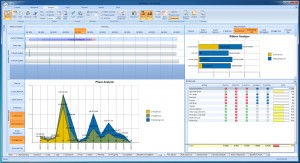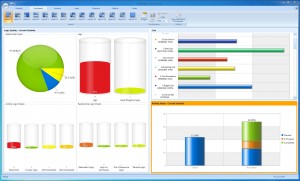This is the sixth entry in the PM Visionary Series.
I recently received an e-mail from Racquel Joseph, the Marketing Coordinator for a new project management software application called Acumen. After saying lots of nice things about my blog (which always makes me all gooey inside), she mentioned the company she works for. I was intrigued. At Acumen, they believe that not enough work has been done to improve project scheduling against risk. In this light, they’ve come up with some terrific solutions!
I’d be very interested in what some of you analysis junkies think of Acumen’s past struggles and current approach. Please welcome the author, Dan Patterson, to the Papercut community with your comments below.
Incidentally, Acumen is hosting a one-day conference in Houston on October 18th, 2011. Registration is free until August 15th, so if you’re in the area, be sure to check it out!
It’s all about the Schedule
Who we are.
Acumen’s DNA is based on a belief that a sound basis of schedule is the absolute key ingredient to successful project management, a concept otherwise described as: “it’s all about the schedule, stupid”. This concept is not only what we as a company live and breathe every day, but is the drive behind our passion and razor-focus on developing software that helps the project management community improve the practice of CPM scheduling.
Background.
This focus on quality scheduling and project analysis comes from a long history and background in PPM. During the mid 1990’s, I spent several years examining the feasibility of using artificial (AI) systems for generating sound project schedules. This work led to a doctorate as well as an associated commercial software product that is still in use today. Most importantly, however, I gained a deep understanding of the required mechanics and integrity that is needed to accurately forecast work in the form of a CPM schedule.
A Shift in Focus
During the next twenty years of my career I saw many CPM scheduling tools get faster, more powerful, and more collaborative, while schedule quality remained mediocre at best. I was continually frustrated that so many projects failed to recognize the importance of this CPM integrity, which in turn bred unrealistic forecasting and unachievable project goals.
Another unanswered question I kept coming back to was “how can a project forecast a single deterministic completion date given so much uncertainty going forward?” This led to a shift in focus towards the area of project risk analytics. As one of the principles of what was at the time the Pertmaster risk analysis company, I quickly ascertained two points of fact that essentially become the underpinnings of Acumen today:
1) A risk-adjusted schedule is much more valuable than a deterministic schedule in terms of helping forecast project completion. This is true for many reasons including:
a. It accounts for uncertainty and complexity of the work being conducted
b. It accounts for overly optimistic planning
c. It encourages the identification of risk events and more importantly the required response to risk (mitigation) by the project team
d. It provides a range of schedule forecasts against which execution can be tracked and controlled
2) While highly insightful, a risk model is only as sound as the two moving parts within the model itself:
a. The integrity of the underlying deterministic CPM schedule
b. The validity of the risk ranges, inputs and scores provided by the project team
While a risk tool such as Primavera PRA/Pertmaster is extremely fast and powerful in it’s ability to run a schedule-based Monte Carlo simulation, the results are only ever as valid as the inputs that are fed into it. While this is a notable challenge for cost-risk models, for schedule-risk models it is, at best, a mission critical factor and, at worst, it is the ultimate downfall.
And then there was Acumen…
Within this context, Acumen was born from the recognized need to help improve schedule models (irrespective of whether they are deterministic CPM or non-deterministic risk-adjusted schedules). To help with achieving this, Acumen developed a schedule maturity framework known as “S1 > S5”™. This five-step maturity scale, with steps for taking a project from a non-validated schedule with questionable achievability to one that is sound, risk-adjusted, and has team buy-in, has since helped numerous projects not only improve the integrity of their CPM schedules, but has additionally enabled them to accurately account for the impact of risk and uncertainty, has given them a structured means of compressing or accelerating the schedule, and provided a forum for ensuring the project team is bought into the schedule.
Hand in hand with the S1>S5 methodology, Acumen developed an enterprise project analysis tool, Fuse, to assist in improving schedule maturity through the use of advanced project analytics.
Today, Fuse provides a repeatable means of actually scoring and critiquing the quality of the plan, assessing project performance during execution, and pinpointing as well as understanding the impact of, changes made to the schedule. Prior to Fuse, this simply wasn’t achievable, with the only options being to use a manual (and therefore timely) analysis or one of a few rudimentary legacy analysis tools. Because of the combination of over 250 different schedule, cost, risk, EV, performance, and logic checks in the form of advanced analytics and unique-to-Fuse metrics, our customers have often described us as “Mad about Analytics”. We are continually adding in new metrics and schedule checks based on customer requests and the ever-growing standards from organizations such as AACE, PMI, NDIA, DCMA, and GAO.
One of the most exciting aspects of Fuse in recent months has been the tremendous uptake and adoption of creating custom analytical components (custom metrics, and user defined reports) directly within Fuse in order to achieve specific project or organization objectives. Such an evolution from being a software tool to more of an all-encompassing project analytics platform is something we are very excited about at Acumen.
The next generation of analytics
Not content with standing still, we have even more exciting plans in the works. October 2011 heralds the introduction of our second analytics product, Fuse360 – a tool that through criteria-based simulation, provides alternate project scenarios based on user defined goals. ”Goal-based optimization”™ – another first for Acumen but certainly not the last! With our embedded beliefs around sound CPM scheduling; strong and proven products; great people and a passion for excellence, we look forward to continuing down our exciting path of Proven Project Analytics.
 Dr. Dan Patterson PMP is the founder of Acumen and is a recognized thought leader and visionary within the project management industry. Prior to starting Acumen, Dan was Executive VP at Pertmaster leading the Americas business unit from inception through to acquisition by Primavera. Dan is also responsible for developing a now widely accepted integrated qualitative/quantitative approach to risk analysis through facilitated risk workshops. His depth of knowledge extends well beyond riskinto schedule analytics and project optimization.
Dr. Dan Patterson PMP is the founder of Acumen and is a recognized thought leader and visionary within the project management industry. Prior to starting Acumen, Dan was Executive VP at Pertmaster leading the Americas business unit from inception through to acquisition by Primavera. Dan is also responsible for developing a now widely accepted integrated qualitative/quantitative approach to risk analysis through facilitated risk workshops. His depth of knowledge extends well beyond riskinto schedule analytics and project optimization.
Dan has a proven track record across multiple industries including A&D, government, energy and EPC. As CEO of Acumen, Dan now places focus on Acumen Fuse, the most advanced & comprehensive project analytics tool available for all versions of Primavera, including the latest release R8 as well as Primavera Risk Analysis.
More information can be found at www.projectacumen.com



